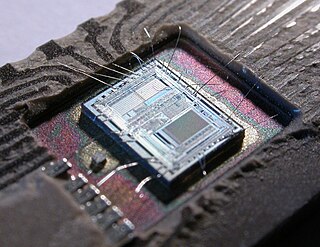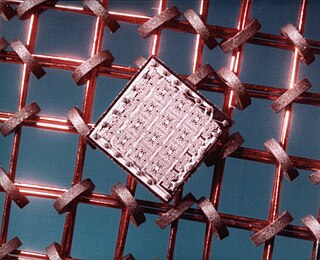Basic structure

Sense amplifier is required during the data read and refresh operation from the memory concerned.
| Circuit Types | Operation Mode |
|---|---|
| Differential | Voltage-mode |
| Nondifferential | Current-mode |
A sense amplifier is a circuit that is used to amplify and detect small signals in electronic systems. It is commonly used in memory circuits, such as dynamic random access memory (DRAM), to read and amplify the weak signals stored in memory cells.
In modern computer memory, a sense amplifier is one of the elements which make up the circuitry on a semiconductor memory chip (integrated circuit); the term itself dates back to the era of magnetic core memory. [1] A sense amplifier is part of the read circuitry that is used when data is read from the memory; its role is to sense the low power signals from a bitline that represents a data bit (1 or 0) stored in a memory cell, and amplify the small voltage swing to recognizable logic levels so the data can be interpreted properly by logic outside the memory. [2]
Modern sense-amplifier circuits consist of two to six (usually four) transistors, while early sense amplifiers for core memory sometimes contained as many as 13 transistors. [3] There is one sense amplifier for each column of memory cells, so there are usually hundreds or thousands of identical sense amplifiers on a modern memory chip. As such, sense amplifiers are one of the few remaining analog circuits in a computer's memory subsystem.

Sense amplifier is required during the data read and refresh operation from the memory concerned.
| Circuit Types | Operation Mode |
|---|---|
| Differential | Voltage-mode |
| Nondifferential | Current-mode |
The data in a semiconductor memory chip is stored in tiny circuits called memory cells. Sense Amplifiers are primarily applied in Volatile memory cells. The memory cells are either SRAM or DRAM cells which are laid out in rows and columns on the chip. Each line is attached to each cell in the row. The lines which run along the rows are called wordlines which are activated by putting a voltage on it. The lines which run along the columns are called bit-line and two such complementary bitlines are attached to a sense amplifier at the edge of the array. Number of sense amplifiers are of that of the "bitline' on the chip. Each cell lies at the intersection of a particular wordline and bitline, which can be used to "address" it. The data in the cells is read or written by the same bit-lines which run along the top of the rows and columns. [4]
To read a bit from a particular memory cell, the wordline along the cell's row is turned on, activating all the cells in the row. The stored value (Logic 0 or 1) from the cell then comes to the Bit-lines associated with it. The sense amplifier at the end of the two complementary bit-lines amplify the small voltages to a normal logic level. The bit from the desired cell is then latched from the cell's sense amplifier into a buffer, and put on the output bus. [5]
The sense amplifier operation in DRAM is quite similar to the SRAM, but it performs an additional function. The data in DRAM chips is stored as electric charge in tiny capacitors in the memory cells. The read operation depletes the charge in a cell, destroying the data, so after the data is read out the sense amplifier must immediately write it back in the cell by applying a voltage to it, recharging the capacitor. This is called memory refresh.
As part of their designs, sense amplifiers aim at a minimum sense delay, required level of amplification, minimum power consumption, fit into restricted layout areas, and high reliability and tolerance.

Computer memory stores information, such as data and programs for immediate use in the computer. The term memory is often synonymous with the term primary storage or main memory. An archaic synonym for memory is store.

Static random-access memory is a type of random-access memory (RAM) that uses latching circuitry (flip-flop) to store each bit. SRAM is volatile memory; data is lost when power is removed.

Dynamic random-access memory is a type of random-access semiconductor memory that stores each bit of data in a memory cell, usually consisting of a tiny capacitor and a transistor, both typically based on metal–oxide–semiconductor (MOS) technology. While most DRAM memory cell designs use a capacitor and transistor, some only use two transistors. In the designs where a capacitor is used, the capacitor can either be charged or discharged; these two states are taken to represent the two values of a bit, conventionally called 0 and 1. The electric charge on the capacitors gradually leaks away; without intervention the data on the capacitor would soon be lost. To prevent this, DRAM requires an external memory refresh circuit which periodically rewrites the data in the capacitors, restoring them to their original charge. This refresh process is the defining characteristic of dynamic random-access memory, in contrast to static random-access memory (SRAM) which does not require data to be refreshed. Unlike flash memory, DRAM is volatile memory, since it loses its data quickly when power is removed. However, DRAM does exhibit limited data remanence.

Synchronous dynamic random-access memory is any DRAM where the operation of its external pin interface is coordinated by an externally supplied clock signal.
Magnetoresistive random-access memory (MRAM) is a type of non-volatile random-access memory which stores data in magnetic domains. Developed in the mid-1980s, proponents have argued that magnetoresistive RAM will eventually surpass competing technologies to become a dominant or even universal memory. Currently, memory technologies in use such as flash RAM and DRAM have practical advantages that have so far kept MRAM in a niche role in the market.
Volatile memory, in contrast to non-volatile memory, is computer memory that requires power to maintain the stored information; it retains its contents while powered on but when the power is interrupted, the stored data is quickly lost.
Semiconductor memory is a digital electronic semiconductor device used for digital data storage, such as computer memory. It typically refers to devices in which data is stored within metal–oxide–semiconductor (MOS) memory cells on a silicon integrated circuit memory chip. There are numerous different types using different semiconductor technologies. The two main types of random-access memory (RAM) are static RAM (SRAM), which uses several transistors per memory cell, and dynamic RAM (DRAM), which uses a transistor and a MOS capacitor per cell. Non-volatile memory uses floating-gate memory cells, which consist of a single floating-gate transistor per cell.
Column address strobe latency, also called CAS latency or CL, is the delay in clock cycles between the READ command and the moment data is available. In asynchronous DRAM, the interval is specified in nanoseconds. In synchronous DRAM, the interval is specified in clock cycles. Because the latency is dependent upon a number of clock ticks instead of absolute time, the actual time for an SDRAM module to respond to a CAS event might vary between uses of the same module if the clock rate differs.
XDR DRAM is a high-performance dynamic random-access memory interface. It is based on and succeeds RDRAM. Competing technologies include DDR2 and GDDR4.
1T-SRAM is a pseudo-static random-access memory (PSRAM) technology introduced by MoSys, Inc. in September 1998, which offers a high-density alternative to traditional static random-access memory (SRAM) in embedded memory applications. Mosys uses a single-transistor storage cell like dynamic random-access memory (DRAM), but surrounds the bit cell with control circuitry that makes the memory functionally equivalent to SRAM. 1T-SRAM has a standard single-cycle SRAM interface and appears to the surrounding logic just as an SRAM would.

Ferroelectric RAM is a random-access memory similar in construction to DRAM but using a ferroelectric layer instead of a dielectric layer to achieve non-volatility. FeRAM is one of a growing number of alternative non-volatile random-access memory technologies that offer the same functionality as flash memory. An FeRAM chip contains a thin film of ferroelectric material, often lead zirconate titanate, commonly referred to as PZT. The atoms in the PZT layer change polarity in an electric field, thereby producing a power-efficient binary switch. However, the most important aspect of the PZT is that it is not affected by power disruption or magnetic interference, making FeRAM a reliable nonvolatile memory.
Memory refresh is the process, for the purpose of preserving the information, of periodically reading information from an area of computer memory and immediately rewriting the read information to the same area without modification. Memory refresh is a background maintenance process required during the operation of semiconductor dynamic random-access memory (DRAM), the most widely used type of computer memory, and in fact is the defining characteristic of this class of memory.

An active-pixel sensor (APS) is an image sensor, which was invented by Peter J.W. Noble in 1968, where each pixel sensor unit cell has a photodetector and one or more active transistors. In a metal–oxide–semiconductor (MOS) active-pixel sensor, MOS field-effect transistors (MOSFETs) are used as amplifiers. There are different types of APS, including the early NMOS APS and the now much more common complementary MOS (CMOS) APS, also known as the CMOS sensor. CMOS sensors are used in digital camera technologies such as cell phone cameras, web cameras, most modern digital pocket cameras, most digital single-lens reflex cameras (DSLRs), mirrorless interchangeable-lens cameras (MILCs), and lensless imaging for cells.

An electronic circuit is composed of individual electronic components, such as resistors, transistors, capacitors, inductors and diodes, connected by conductive wires or traces through which electric current can flow. It is a type of electrical circuit and to be referred to as electronic, rather than electrical, generally at least one active component must be present. The combination of components and wires allows various simple and complex operations to be performed: signals can be amplified, computations can be performed, and data can be moved from one place to another.

Read-only memory (ROM) is a type of non-volatile memory used in computers and other electronic devices. Data stored in ROM cannot be electronically modified after the manufacture of the memory device. Read-only memory is useful for storing software that is rarely changed during the life of the system, also known as firmware. Software applications for programmable devices can be distributed as plug-in cartridges containing ROM.

Random-access memory is a form of electronic computer memory that can be read and changed in any order, typically used to store working data and machine code. A random-access memory device allows data items to be read or written in almost the same amount of time irrespective of the physical location of data inside the memory, in contrast with other direct-access data storage media, where the time required to read and write data items varies significantly depending on their physical locations on the recording medium, due to mechanical limitations such as media rotation speeds and arm movement.

The memory cell is the fundamental building block of computer memory. The memory cell is an electronic circuit that stores one bit of binary information and it must be set to store a logic 1 and reset to store a logic 0. Its value is maintained/stored until it is changed by the set/reset process. The value in the memory cell can be accessed by reading it.
Row hammer is a security exploit that takes advantage of an unintended and undesirable side effect in dynamic random-access memory (DRAM) in which memory cells interact electrically between themselves by leaking their charges, possibly changing the contents of nearby memory rows that were not addressed in the original memory access. This circumvention of the isolation between DRAM memory cells results from the high cell density in modern DRAM, and can be triggered by specially crafted memory access patterns that rapidly activate the same memory rows numerous times.

MOSAID is a semiconductor technology company incorporated in Ottawa, Canada. It was founded in 1975 as a DRAM design company, and later branched out into other areas including EDA software, semiconductor reverse engineering, test equipment manufacturing and intellectual property licensing. MOSAID went public in 1994 with a listing on the Toronto Stock Exchange under ticker symbol "MSD". By 2011 the business was based exclusively on patent licensing and the company was acquired by Sterling Partners, a US-based private equity firm. MOSAID was renamed Conversant Intellectual Property Management in 2013. In 2021, the company announced it was changing its name back to MOSAID.